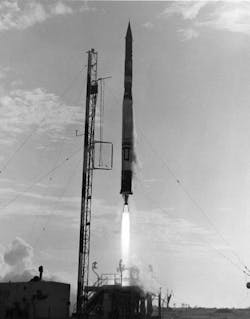Orbiting satellites are now taken for granted, and often part of daily communications networks or entertainment services. But 60 years ago, the U.S. Navy’s Vanguard I satellite became only the second U.S. satellite placed into Earth’s orbit. It followed the launch of its U.S. predecessor, the Army’s Explorer I satellite, and two earlier Sputnik satellites from the Soviet Union. The launch of Vanguard I (see figure) came on the second try, with the first attempt crashing on the rocket launch pad about three months earlier.
The tiny aluminum satellite, part of the Navy’s Vanguard Project, is only 16.5 cm in diameter. It was placed in orbit at an altitude of almost 2500 miles. John Dchaub, director of the Naval Center of Space Technology (NCST) at NRL, looks back at the event: “We are still in awe of what the Vanguard team accomplished 60 years ago. In just 30 months, with the successful launch of Vanguard I, their work brought to culmination the efforts of America’s first official space satellite program.”
Vanguard I was launched on March 17, 1958 from Cape Canaveral in Florida. (Courtesy of Naval Research Lab)
The miniature orbiting satellite proved invaluable to gaining a better understanding of upper atmospheric physics, geodynamics, dynamical astronomy, and solar terrestrial relationships. The satellite itself served to measure the effects of a space environment on an orbiting spacecraft. The satellite included a number of instruments powered by batteries or photovoltaic cells, including a Minitrack beacon, a set of mercury batteries, a 108-MHz transmitter, and two temperature sensors.
The transmitters were used to send engineering and tracking data, but also to determine the total electron content between the satellite and the Navy’s ground stations. The mercury batteries lasted for 20 days but the solar cells, developed by the Army Corps of Engineers, provided power for seven years. Even though data transmissions fell silent in 1964, the satellite continues to orbit the Earth 60 years later.


